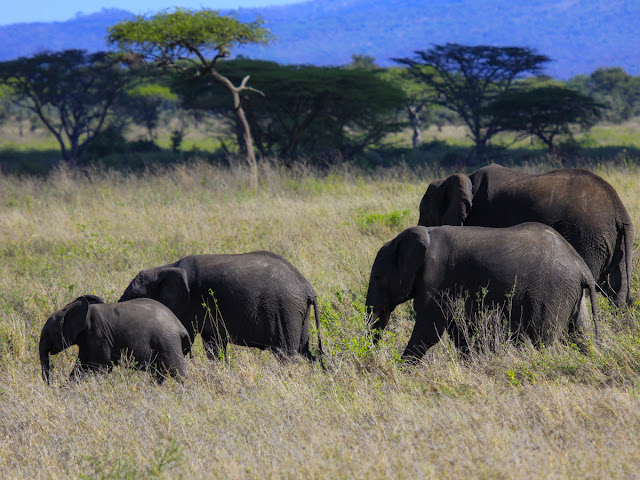Day three in the Serengeti.
It is our mission today to see a leopard, the only remaining animal on our list.
Our efforts are rewarded, not once but twice.
It is difficult to spot a leopard. They tend to camoflouge themselves by perching high in the branches of the trees. This is partly so they can spot potential prey, but also to be safe from the lions.
A group of jeeps is clustered up ahead. That indicates they have spotted something. We join them. There, high in the cleft of a tree is a leopard with its kill. It has dragged its kill, an antelope, up the tree where it is secured in the branches. The leopard is watchful and see a male lion in the distance.
It is a magnificent animal, powerful, alert, beautiful. Shooting with a long lens we capture shot after shot, hopeful they are sharp enough to crop in close.
As the day continues we encounter a group of giraffes very near the road, allowing us better, closer images than before, allowing us to see clearly their head and eyes.
 We come upon a pride of lions – females and their cubs – in the shade of large acacia tree just on the edge of the road. We stop, with our windows down and cameras ready we are so close the lions can look right in the window. I look out, right into the eyes of the lioness.
We come upon a pride of lions – females and their cubs – in the shade of large acacia tree just on the edge of the road. We stop, with our windows down and cameras ready we are so close the lions can look right in the window. I look out, right into the eyes of the lioness.
The hair on the back of my neck stands up. Slowly I raise my camera. The lion does not move, but it is unsettling. Our driver assures us they do not see us as humans or individuals. To them we are a large dark shape. It is only quick movement of noise that will alert them.
We have spotted another leopard. It is moving through the long grass between trees. We watch as it climbs the tree, too distant for a decent photo. So, we carefully manouever our convoy around to the other side, attempting to get nearer. Here we can get close, beneath the tree, hoping it does not decide to leap down.
We head back to camp. We have seen every animal on our list now. Tomorrow we must leave this unbelievable place.
But as we head to the airport the next morning we have a couple of more treats in store.
 As we make our way across the plains to the Serengeti airstrip, we encounter a group of elephants. They are moving and we anticipate they will cross our path ahead. We approach the line they will cross and wait. The elephants are right around our jeeps. One turns, facing one of our jeeps. Its ears flare and it moves directly toward the jeep. For an instant we think it may charge the vehicle. It approaches, then veers off and moves on.
As we make our way across the plains to the Serengeti airstrip, we encounter a group of elephants. They are moving and we anticipate they will cross our path ahead. We approach the line they will cross and wait. The elephants are right around our jeeps. One turns, facing one of our jeeps. Its ears flare and it moves directly toward the jeep. For an instant we think it may charge the vehicle. It approaches, then veers off and moves on.
We continue, and come upon a large pride of lions. They lie on both sides of the road. Some slowly amble across the road, weaving between the jeeps, so close and unbothered by our presence. We shoot through windows and the roof. Our jeeps are still and the lions see them as shade from the heat. One walks slowly right alongside our jeep and lies down in the shade right below my window. I could reach out and touch it. (not a good idea). A second one follows and plops itself down beside the first.
We are speechless and thrilled. The perfect ending to our photo safari.
We make our way to the airstrip and board or charter back to Arusha for our connecting flight to Zanzibar. We say goodbye to our amazing guide and drivers and to our new friends.
 |
| Victor, our guide, on our flight out of the Serengeti to Arusha, where we will connect to Zanzibar. |
We board our next plane to Zanzibar for the final chapter. Come With Me….



































































